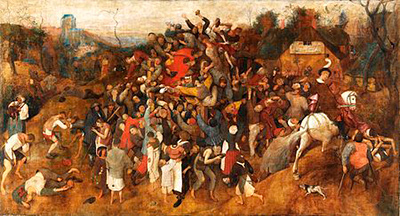The Wine of Saint Martin's Day was painted by Pieter Bruegel the Elder between 1565 and 1568.
As the name suggests, it depicts a large group of peasants celebrating Saint Martin's Day.
The festival marks the start of winter in the agricultural calendar, when autumn seeding is finished, animals are slaughtered in preparation for winter and newly-harvested wine is ready to be drunk, which many of the painting’s subjects can be seen partaking in.
Bruegel has also included an allusion to the best-known legend of Saint Martin in the painting’s far right. The story says that Saint Martin, coming upon an unfortunate beggar, cut his cloak in half to share with the man to keep him warm. This is Bruegel’s largest known piece, measuring 148 by 270.5 centimetres, but was not identified as one of his works until 2010.
The medium is glue-size, also known as distemper, on linen, which was used by Bruegel in several of his paintings, including The Blind Leading the Blind. In this method animal hide glue is used to bind pigment to cloth. Unfortunately, due to the deterioration of both the glue and linen over time, works in this medium are very fragile and many have not survived.
The Wine of Saint Martin's Day was in poor condition when it was brought by its owners to the Museo del Prado in 2010. X-rays of the surface revealed fragments of Bruegel’s signature to confirm it as his work.
The date, however, was missing, but was estimated to be between 1565 and 1568 as it matches the style of Bruegel's other late works. The museum was able to restore the piece and subsequently acquired it for display in their galleries.




